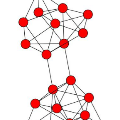This study introduces "Survey and Questionnaire Item Embeddings Differentials" (SQuID), a novel methodological approach that enables neural network embeddings to effectively recover latent dimensions from psychometric survey items. We demonstrate that embeddings derived from large language models, when processed with SQuID, can recover the structure of human values obtained from human rater judgments on the Revised Portrait Value Questionnaire (PVQ-RR). Our experimental validation compares multiple embedding models across a number of evaluation metrics. Unlike previous approaches, SQuID successfully addresses the challenge of obtaining negative correlations between dimensions without requiring domain-specific fine-tuning. Quantitative analysis reveals that our embedding-based approach explains 55% of variance in dimension-dimension similarities compared to human data. Multidimensional scaling configurations from both types of data show fair factor congruence coefficients and largely follow the underlying theory. These results demonstrate that semantic embeddings can effectively replicate psychometric structures previously established through extensive human surveys. The approach offers substantial advantages in cost, scalability and flexibility while maintaining comparable quality to traditional methods. Our findings have significant implications for psychometrics and social science research, providing a complementary methodology that could expand the scope of human behavior and experience represented in measurement tools.
翻译:暂无翻译




